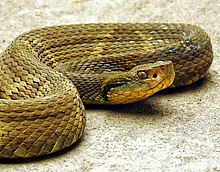| Bothrops jararaca | |
|---|---|

| |
| Scientific classification | |
| Domain: | Eukaryota |
| Kingdom: | Animalia |
| Phylum: | Chordata |
| Class: | Reptilia |
| Order: | Squamata |
| Suborder: | Serpentes |
| Family: | Viperidae |
| Genus: | Bothrops |
| Species: | B. jararaca
|
| Binomial name | |
| Bothrops jararaca (Wied-Neuwied, 1824)
| |
| Synonyms | |
| |
Bothrops jararaca—known as the jararaca[4] or yarara[5]—is a highly venomous pit viper species endemic to South America in southern Brazil, Paraguay, and northern Argentina. The specific name, jararaca, is derived from Old Tupi îararaka. Within its geographic range, it is often abundant and is an important cause of snakebite.[4] No subspecies are currently recognized.[6]
The drugs known as angiotensin converting enzyme (ACE) inhibitors, used for the treatment of hypertension and some types of congestive heart failure, were developed from a peptide found in the venom of this species.
- ^ Cacciali, P.; Carreira, S.; Kacoliris, F.; Montero, R.; Pelegrin, N.; Scott, N. (2019). "Bothrops jararaca". IUCN Red List of Threatened Species. 2019: e.T15203324A15203411. doi:10.2305/IUCN.UK.2019-2.RLTS.T15203324A15203411.en. Retrieved 28 July 2024.
- ^ McDiarmid RW; Campbell JA; Touré T (1999). Snake Species of the World: A Taxonomic and Geographic Reference. Vol. 1. Herpetologists' League. ISBN 1-893777-01-4.
- ^ "Bothropoides jararaca (WIED, 1824)". The Reptile Database.
- ^ a b Campbell JA, Lamar WW (2004). The Venomous Reptiles of the Western Hemisphere. Comstock. ISBN 0-8014-4141-2. LCCN 2003007834.
- ^ U. S. Navy (1991). Poisonous Snakes of the World. US Govt.; Dover Publications. ISBN 0-486-26629-X.
- ^ "Bothrops jararaca". Integrated Taxonomic Information System. Retrieved 21 January 2007.
